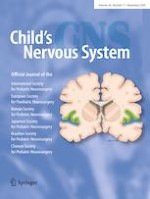Erschienen in:

26.03.2020 | Original Article
Neurophysiologic intraoperative monitoring (NIOM) in pediatric patients with polyneuropathy
verfasst von:
Jennifer L. McKinney, Monica P. Islam
Erschienen in:
Child's Nervous System
|
Ausgabe 11/2020
Einloggen, um Zugang zu erhalten
Abstract
Purpose
Neurophysiologic intraoperative monitoring (NIOM) abnormalities during scoliosis surgery led to a diagnosis of Friedreich’s ataxia in this illustrative case. This prompted the retrospective examination of NIOM for pediatric scoliosis surgery in polyneuropathy patients.
Methods
Among patients who underwent scoliosis surgery in 2010–2017, there were six polyneuropathy patients identified. Their clinical history and baseline NIOM data were reviewed.
Results
Scoliosis accompanied Charcot–Marie–Tooth disease, Friedreich’s ataxia, and ataxia telangiectasia. Some patients with no recorded somatosensory evoked potentials (SEPs) exhibited motor evoked potentials (MEPs); no patients with absent MEPs had SEPs present. NIOM modifications included SEP stimulation rate; type of SEP electrodes used; train parameters for MEP acquisition; and sweep speed.
Conclusions
This sample of NIOM data for previously monitored scoliosis cases in children with polyneuropathy allowed investigation of patterns of findings and troubleshooting attempts to optimize monitoring. Attentiveness to pertinent medical history prepared the NIOM team to change typical recording parameters based on underlying polyneuropathy. A multimodality approach provided useful information as several of these cases would have been unmonitorable with use of SEPs alone. As for the case described, the awareness of NIOM patterns in polyneuropathy may guide evaluations of patients with presumed idiopathic scoliosis who have unrecognized polyneuropathy.